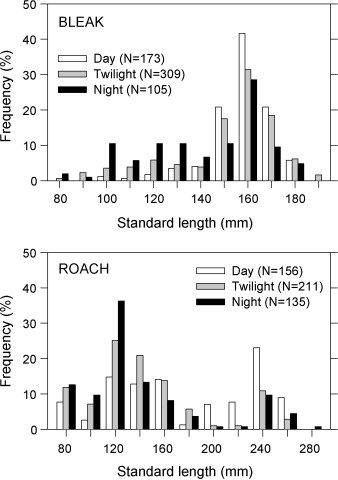 he diel changes in gillnet catch rates and vertical distributions of pelagic fishes were determined in a deep, moderately eutrophic European reservoir. In late summer, when steep vertical gradients in temperature and dissolved oxygen developed in the reservoir, monofilament gillnets (12.5–70 mm bar mesh) covering the upper 7.5 m of the water column were set at two open-water locations over 44- and 46-h periods, respectively. Gillnets divided the sampled strata (i.e., the epilimnion and metalimnion) into five horizontal layers each 1.5 m thick. Captured fish were removed from the nets at regular 2-h intervals. The catches were numerically dominated by bleak Alburnus alburnus, roach Rutilus rutilus, perch Perca fluviatilis, bream Abramis brama and asp Aspius aspius. Catch rates varied considerably with the time of day. The total gillnet catch per 2-h was on average 3–4 times higher at twilight than during the day or at night. Decreased net visibility and increased fish activity were likely responsible for the high gillnet catches at dusk and dawn periods. The catches of individual species were not distributed uniformly across the five sampled depth layers. The majority of bleak and asp were captured in the surface layer (0–1.5 m), irrespective of day, twilight or night. During the daytime, roach were most abundant in the layer just above the thermocline (3–4.5 m), but at night they occupied the upper part of the epilimnion (0–3 m). Perch inhabited the lower epilimnion and the upper metalimnion (1.5–6 m), and were caught only during daytime and twilight. For bleak and roach, greater proportions of larger individuals were caught during the day, while proportions of smaller fish increased in twilight and night catches. This implies that individuals of the two species made diel migrations between pelagic and littoral habitats.
he diel changes in gillnet catch rates and vertical distributions of pelagic fishes were determined in a deep, moderately eutrophic European reservoir. In late summer, when steep vertical gradients in temperature and dissolved oxygen developed in the reservoir, monofilament gillnets (12.5–70 mm bar mesh) covering the upper 7.5 m of the water column were set at two open-water locations over 44- and 46-h periods, respectively. Gillnets divided the sampled strata (i.e., the epilimnion and metalimnion) into five horizontal layers each 1.5 m thick. Captured fish were removed from the nets at regular 2-h intervals. The catches were numerically dominated by bleak Alburnus alburnus, roach Rutilus rutilus, perch Perca fluviatilis, bream Abramis brama and asp Aspius aspius. Catch rates varied considerably with the time of day. The total gillnet catch per 2-h was on average 3–4 times higher at twilight than during the day or at night. Decreased net visibility and increased fish activity were likely responsible for the high gillnet catches at dusk and dawn periods. The catches of individual species were not distributed uniformly across the five sampled depth layers. The majority of bleak and asp were captured in the surface layer (0–1.5 m), irrespective of day, twilight or night. During the daytime, roach were most abundant in the layer just above the thermocline (3–4.5 m), but at night they occupied the upper part of the epilimnion (0–3 m). Perch inhabited the lower epilimnion and the upper metalimnion (1.5–6 m), and were caught only during daytime and twilight. For bleak and roach, greater proportions of larger individuals were caught during the day, while proportions of smaller fish increased in twilight and night catches. This implies that individuals of the two species made diel migrations between pelagic and littoral habitats.
Keywords: CPUE; diel catchability; distribution; epilimnetic fishes; gillnet; man-made lake
